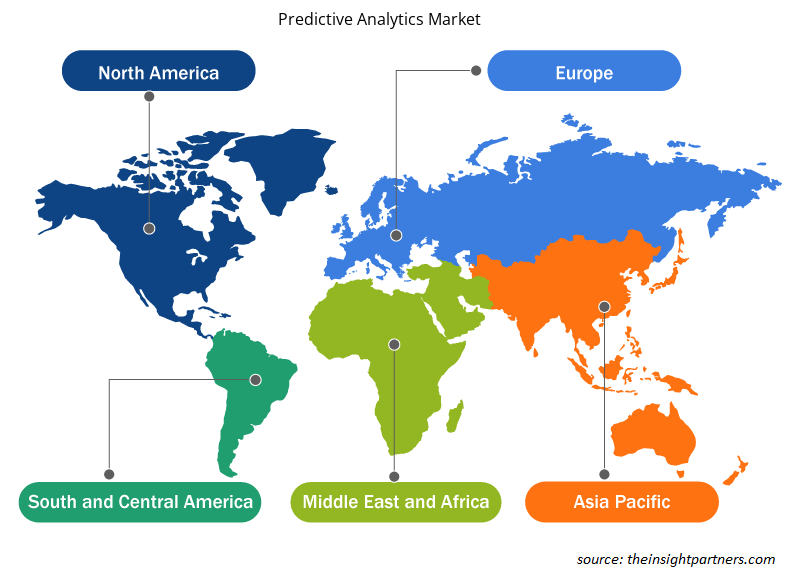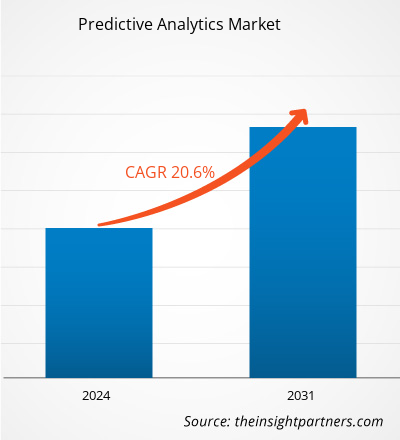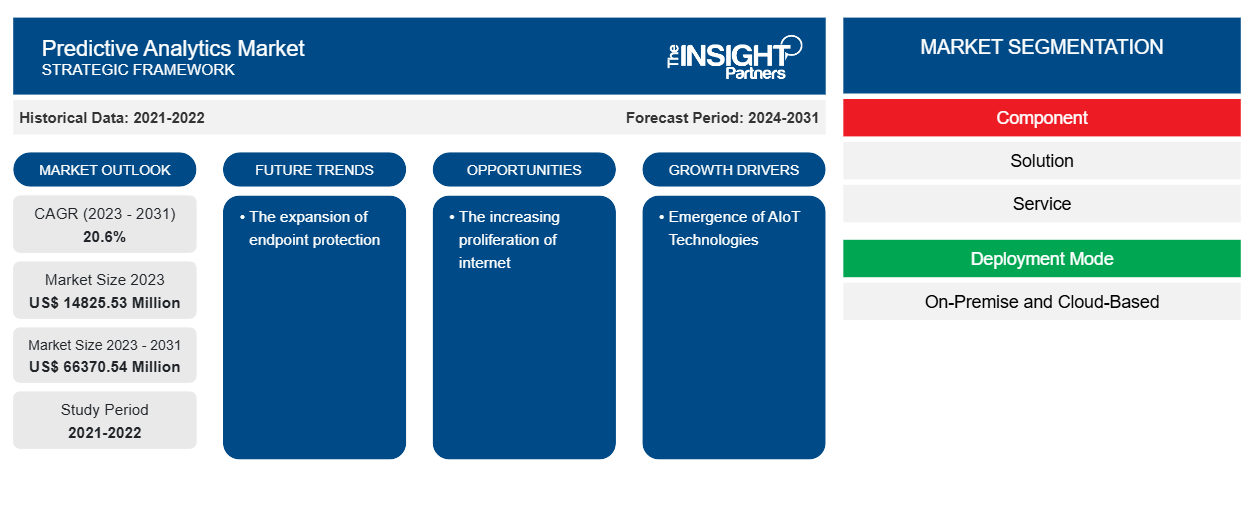Der Markt für Predictive Analytics soll von 14.825,53 Millionen US-Dollar im Jahr 2023 auf 66.370,54 Millionen US-Dollar im Jahr 2031 anwachsen. Der Markt wird zwischen 2023 und 2031 voraussichtlich eine durchschnittliche jährliche Wachstumsrate (CAGR) von 20,6 % verzeichnen. Der Ausbau des Endgeräteschutzes dürfte ein wichtiger Trend auf dem Markt bleiben.
Predictive Analytics Marktanalyse
Mit der weitverbreiteten Einführung ausgefeilter Predictive-Analytics-Tools nutzen Unternehmen heute Big Data, um Möglichkeiten und Gefahren proaktiv zu erkennen. Dank moderner Technologie ist Predictive Analytics heute zugänglicher denn je. Ein Unternehmen muss einen Geschäftszweck identifizieren, bevor es Predictive Analytics nutzen kann, sei es zur Steigerung des Umsatzes, zur Optimierung von Prozessen oder zur Verbesserung der Kundenzufriedenheit. Anschließend kann dieses Unternehmen mit den richtigen Tools Predictive-Analytics-Modelle erstellen, umsetzbare Erkenntnisse gewinnen und enorme Mengen heterogener Daten durchforsten, um dieses Ziel zu erreichen.
Marktübersicht für prädiktive Analysen
Predictive Analytics ist ein Teilgebiet der fortgeschrittenen Analytik , das historische Daten zusammen mit statistischer Modellierung, Data Mining und maschinellem Lernen verwendet, um zukünftige Ereignisse vorherzusagen. Unternehmen verwenden Predictive Analytics, um in diesen Daten nach Trends zu suchen und so Möglichkeiten und Gefahren zu erkennen. Predictive Analytics wird häufig mit Data Science und Big Data in Verbindung gebracht. Unternehmen sind derzeit mit Daten überlastet, die in verschiedenen Datenspeichern im gesamten Unternehmen gespeichert sind und Protokolldateien, Fotos und Videos umfassen. Datenwissenschaftler verwenden maschinelles Lernen und Deep-Learning-Algorithmen, um Trends in den Daten zu erkennen und zukünftige Ereignisse vorherzusagen, um wertvolle Erkenntnisse zu gewinnen. Neuronale Netzwerke, Entscheidungsbäume, logistische und lineare Regressionsmodelle und andere statistische Techniken sind einige davon. Bestimmte Modellierungsstrategien nutzen vorläufige Vorhersageerkenntnisse, um prädiktivere Erkenntnisse zu erhalten.
Passen Sie diesen Bericht Ihren Anforderungen an
Sie erhalten kostenlose Anpassungen an jedem Bericht, einschließlich Teilen dieses Berichts oder einer Analyse auf Länderebene, eines Excel-Datenpakets sowie tolle Angebote und Rabatte für Start-ups und Universitäten.
-
Holen Sie sich die wichtigsten Markttrends aus diesem Bericht.Dieses KOSTENLOSE Beispiel umfasst eine Datenanalyse von Markttrends bis hin zu Schätzungen und Prognosen.
Treiber und Chancen des Predictive Analytics-Marktes
Entstehung von AIoT-Technologien
Die Infrastruktur des Internets der Dinge (IoT) und Technologien der künstlichen Intelligenz (KI) bilden zusammen die künstliche Intelligenz der Dinge (AIoT). AIoT zielt darauf ab, Datenmanagement und -analyse, Mensch-Maschine-Interaktionen und die Effizienz von IoT-Operationen zu verbessern. Künstliche Intelligenz (KI) wird häufig in den Bereichen Spracherkennung, maschinelles Sehen und Verarbeitung natürlicher Sprache eingesetzt. KI ist die Emulation menschlicher Intelligenzprozesse durch Computer, insbesondere Computersysteme. Das Internet der Dinge (IoT) ist ein System aus miteinander verbundenen Computergeräten, digitalen und mechanischen Maschinen oder Gegenständen, die Daten über ein Netzwerk ohne Mensch-zu-Mensch- oder Mensch-zu-Computer-Schnittstelle kommunizieren können. AIoT ist revolutionär und für beide Arten von Technologie von Vorteil, da KI die Entscheidungsfindung verbessert und durch maschinelle Lernfähigkeiten dem IoT einen Mehrwert verleiht.IoT) infrastructure and artificial intelligence (AI) technologies come together to form the AIoT). AIoT seeks to increase data management and analysis, human-machine interactions, and IoT operations efficiency. Artificial Intelligence (AI) is widely utilized in speech recognition, machine vision, and natural language processing. AI is the emulation of human intelligence processes by computers, notably computer systems. The Internet of Things (IoT) is a system of interconnected computing devices, digital and mechanical machinery, or items that may communicate data over a network without a human-to-human or human-to-computer interface. AIoT is revolutionary and advantageous to both kinds of technology, as AI improves decision-making and adds value to IoT through machine learning capabilities.
Die zunehmende Verbreitung des Internets
Die Verbreitung des Internets nimmt weltweit zu. Die zunehmende Nutzung von Alternativen für die Beleuchtung von Umwelttunnelsystemen schafft somit weitere Chancen für den Markt. Anfang April 2024 gab es weltweit 5,44 Milliarden Internetnutzer, das sind 67,1 Prozent der gesamten Weltbevölkerung. Diese erstaunliche Zahl zeigt, dass es mittlerweile mehr als doppelt so viele Internetnutzer wie Nichtnutzer gibt, was die Internetnutzer zu einer „Supermehrheit“ macht. Auch die Zahl der Internetnutzer nimmt zu; den jüngsten Zahlen zufolge wurden im Jahr bis April 2024 weltweit 178 Millionen Menschen zusätzlich verbunden. Daher schafft die zunehmende Verbreitung des Internets verschiedene Chancen für den Markt für prädiktive Analysen.supermajority." The number of people using the internet is also increasing; according to the most recent figures, 178 million more people worldwide became connected in the year ending in April 2024. Therefore, the increasing internet proliferation is creasting various opportunities for the predictive analytics market.
Segmentierungsanalyse des Predictive Analytics-Marktberichts
Wichtige Segmente, die zur Ableitung der Marktanalyse für prädiktive Analysen beigetragen haben, sind Komponente, Bereitstellungsmodus, Organisationsgröße und Branche.
- Basierend auf der Komponente ist der Markt für Predictive Analytics in Lösungen (Risikoanalyse, Marketinganalyse, Verkaufsanalyse, Kundenanalyse und andere) und Dienstleistungen unterteilt. Das Segment Lösungen hatte im Jahr 2023 einen größeren Marktanteil.
- Nach Bereitstellungsmodus ist der Markt in On-Premise und Cloud-basiert segmentiert. Das Cloud-Segment hatte im Jahr 2023 einen größeren Marktanteil.
- Nach Unternehmensgröße ist der Markt in kleine und mittlere Unternehmen (KMU) sowie Großunternehmen segmentiert.SMEs) and large enterprises.
- Nach Branchen ist der Markt in IT und Telekommunikation, BFSI, Energie und Versorgung, Regierung und Verteidigung, Einzelhandel und E-Commerce, Fertigung und Sonstige segmentiert.BFSI, energy & utilities, government and defence, retail and e-commerce, manufacturing, and others.
Predictive Analytics Marktanteilsanalyse nach Geografie
Der geografische Umfang des Marktberichts zur prädiktiven Analytik ist hauptsächlich in fünf Regionen unterteilt: Nordamerika, Asien-Pazifik, Europa, Naher Osten und Afrika sowie Süd- und Mittelamerika.
APAC dominiert den Markt für Predictive Analytics. Der Markt für Predictive Analytics in dieser Region wächst aufgrund verschiedener Faktoren, wie der zunehmenden Internetnutzung und des technologischen Fortschritts. Unternehmen in der Region investieren mehr Geld und Energie in die Entwicklung intelligenter Managementlösungen, die auf die Bewältigung von Sicherheitsbedrohungen im Zusammenhang mit Homeoffice-Modellen zugeschnitten sind. Daher wird der dominates the predictive analytics market. The predictive analytics market in this region is growing due to various factors, such as increasing internet usage and technological advancements. Businesses in the region are investing more money and energy into identifying intelligent management solutions tailored to managing security threats associated with work-from-home models. Thus, the Markt für Predictive Analytics in den nächsten Jahren voraussichtlich ein erhebliches Wachstum verzeichnen.
Regionale Einblicke in den Predictive Analytics-Markt
Die regionalen Trends und Faktoren, die den Predictive Analytics-Markt im Prognosezeitraum beeinflussen, wurden von den Analysten von Insight Partners ausführlich erläutert. In diesem Abschnitt werden auch die Marktsegmente und die Geografie von Predictive Analytics in Nordamerika, Europa, im asiatisch-pazifischen Raum, im Nahen Osten und Afrika sowie in Süd- und Mittelamerika erörtert.

- Holen Sie sich die regionalspezifischen Daten für den Predictive Analytics-Markt
Umfang des Marktberichts zu prädiktiver Analytik
| Berichtsattribut | Details |
|---|---|
| Marktgröße im Jahr 2023 | 14825,53 Millionen US-Dollar |
| Marktgröße bis 2031 | 66370,54 Millionen US-Dollar |
| Globale CAGR (2023 - 2031) | 20,6 % |
| Historische Daten | 2021-2022 |
| Prognosezeitraum | 2024–2031 |
| Abgedeckte Segmente |
Nach Komponente
|
| Abgedeckte Regionen und Länder |
Nordamerika
|
| Marktführer und wichtige Unternehmensprofile |
|
Dichte der Marktteilnehmer im Bereich Predictive Analytics: Die Auswirkungen auf die Geschäftsdynamik verstehen
Der Markt für Predictive Analytics wächst rasant, angetrieben durch die steigende Nachfrage der Endnutzer aufgrund von Faktoren wie sich entwickelnden Verbraucherpräferenzen, technologischen Fortschritten und einem größeren Bewusstsein für die Vorteile des Produkts. Mit steigender Nachfrage erweitern Unternehmen ihr Angebot, entwickeln Innovationen, um die Bedürfnisse der Verbraucher zu erfüllen, und nutzen neue Trends, was das Marktwachstum weiter ankurbelt.
Die Marktteilnehmerdichte bezieht sich auf die Verteilung der Firmen oder Unternehmen, die in einem bestimmten Markt oder einer bestimmten Branche tätig sind. Sie gibt an, wie viele Wettbewerber (Marktteilnehmer) in einem bestimmten Marktraum im Verhältnis zu seiner Größe oder seinem gesamten Marktwert präsent sind.
Die wichtigsten auf dem Predictive Analytics-Markt tätigen Unternehmen sind:
- IBM Corporation
- Microsoft Corporation
- Oracle Corporation
- SAP SE
- Google LLC
- SAS Institute Inc.
Haftungsausschluss : Die oben aufgeführten Unternehmen sind nicht in einer bestimmten Reihenfolge aufgeführt.

- Überblick über die wichtigsten Akteure auf dem Predictive Analytics-Markt
Predictive Analytics-Marktnachrichten und aktuelle Entwicklungen
Der Markt für Predictive Analytics wird durch die Erhebung qualitativer und quantitativer Daten aus Primär- und Sekundärforschung bewertet, die wichtige Unternehmenspublikationen, Verbandsdaten und Datenbanken umfasst. Nachfolgend sind einige der Entwicklungen auf dem Markt für Predictive Analytics aufgeführt:
- mPulse, ein führender Anbieter von Konversations-KI und digitalen Engagement-Lösungen für die Gesundheitsbranche, meldete für das 1. Quartal 2024 gegenüber dem 1. Quartal 2023 eine starke Dynamik mit Wachstum in allen Geschäftsbereichen. Das Unternehmen kündigte außerdem die Einführung seiner integrierten Produktfunktionen für prädiktive Analysen und Omnichannel-Engagement an und etabliert damit eine neue Kategorie innerhalb des digitalen Gesundheitsökosystems. (Quelle: mPulse, Pressemitteilung, Mai 2024)
- AVEVA, ein weltweit führender Anbieter von Industriesoftware, der Innovation und Nachhaltigkeit vorantreibt, gab die Einführung seiner neuesten Version der Software AVEVA Predictive Analytics bekannt, die speziell für die vorausschauende Überwachung von Industrieanlagen in den Bereichen Öl und Gas, Energie, Chemie, Bergbau und Mineralien sowie Fertigung entwickelt wurde. Die Software hilft Industriebetreibern, die höchstmögliche Zuverlässigkeit und Leistung von Industrieanlagen zu erreichen und gleichzeitig die Nachhaltigkeit zu verbessern und die Produktivität der Belegschaft zu steigern. (Quelle: AVEVA, Pressemitteilung, Februar 2023)
Marktbericht zu prädiktiver Analytik: Abdeckung und Ergebnisse
Der Bericht „Marktgröße und Prognose für Predictive Analytics (2021–2031)“ bietet eine detaillierte Analyse des Marktes, die die folgenden Bereiche abdeckt:
- Predictive Analytics-Marktgröße und -prognose auf globaler, regionaler und Länderebene für alle wichtigen Marktsegmente, die im Rahmen des Berichts abgedeckt sind
- Markttrends und Marktdynamiken im Bereich Predictive Analytics wie Treiber, Einschränkungen und wichtige Chancen
- Detaillierte PEST/Porters Five Forces- und SWOT-Analyse
- Predictive Analytics-Marktanalyse, die wichtige Markttrends, globale und regionale Rahmenbedingungen, wichtige Akteure, Vorschriften und aktuelle Marktentwicklungen umfasst
- Branchenlandschaft und Wettbewerbsanalyse, einschließlich Marktkonzentration, Heatmap-Analyse, prominenten Akteuren und aktuellen Entwicklungen für den Predictive Analytics-Markt
- Detaillierte Firmenprofile
- Historische Analyse (2 Jahre), Basisjahr, Prognose (7 Jahre) mit CAGR
- PEST- und SWOT-Analyse
- Marktgröße Wert/Volumen – Global, Regional, Land
- Branchen- und Wettbewerbslandschaft
- Excel-Datensatz
Aktuelle Berichte
Erfahrungsberichte
Grund zum Kauf
- Fundierte Entscheidungsfindung
- Marktdynamik verstehen
- Wettbewerbsanalyse
- Kundeneinblicke
- Marktprognosen
- Risikominimierung
- Strategische Planung
- Investitionsbegründung
- Identifizierung neuer Märkte
- Verbesserung von Marketingstrategien
- Steigerung der Betriebseffizienz
- Anpassung an regulatorische Trends























 Kostenlose Probe anfordern für - Markt für prädiktive Analysen
Kostenlose Probe anfordern für - Markt für prädiktive Analysen